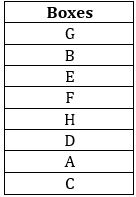Directions (1-5): Study the following information carefully and answer the given questions.
There are eight boxes i.e. A, B, C, D, E, F, G and H which are kept one above the other but not necessarily in the same order. Three boxes are placed between box F and box C. Box F is placed above box C. Box B is placed at second position from the top. Box E is placed just above the box F. Only one box is placed between box H and box A. Box D is placed just above box A.
Q1. Which of the following boxes is placed at the bottommost position?
(a) G
(b) E
(c) C
(d) A
(e) None of these
Q2. How many boxes are placed between box D and box G?
(a) Two
(b) One
(c) Three
(d) None
(e) More than three
Q3. Which of the following statements is true about box G?
(a) Two boxes are placed above box G
(b) Box A is placed just above box G
(c) Three boxes are placed between box E and Box G
(d) Box G is placed at the topmost position
(e) All are true
Q4. Which of the following box is placed just above the box D?
(a) H
(b) B
(c) G
(d) C
(e) None of these
Q5. What is the position of box A?
(a) Just below box G
(b) At third position from the top
(c) Placed below box F
(d) None of these
(e) At fourth position from the bottom
Directions (6-10): In these questions, relationship between different elements is shown in the statements. These statements are followed by two conclusions.
Mark answer as
(a) If only conclusion I follows.
(b) If only conclusion II follows.
(c) If either conclusion I or II follows.
(d) If neither conclusion I nor II follows.
(e) If both conclusions I and II follow.
Q6. Statements: A>K>D>L, M≤C≤D, L>Q
Conclusions: I. C < K
II. A > M
Q7. Statements: T ≥ M ≥ E, E<O, A>E>S
Conclusions: I. T > O
II. S < O
Q8. Statements: G≥C>U, P=W≥U, W<N<T
Conclusions: I. G > T
II. U < N
Q9. Statements: R>Q>J>D, M≤C≤J
Conclusions: I. D > M
II. M ≥ D
Q10. Statements: Z≥V>U, R=E<U, E>M<O
Conclusions: I. Z > E
II. U < O
Directions (11-15): In these questions, relationship between different elements is shown in the statements. The statements are followed by two conclusions.
Give answer
(a) If only conclusion I is true
(b) If only conclusion II is true
(c) If either conclusion I or II is true
(d) If neither conclusion I nor II is true
(e) If both conclusions I and II are true
Q11.Statements: E ≤ F > C ≥ B; F < K≤ T; T ≤ D > H
Conclusions: I. E<K
II.K<H
Q12.Statements: M>N<P≥ B; S< B≤ T; K >G ≤ S
Conclusions: I. P>S
II.B>S
Q13.Statements: M<N>X= B; N≤ T=O; T >G ≤ S
Conclusions: I. M>T
II.M≤O
Q14.Statements: W<X=Y>Z; B=C≤X; A=Y≥U
Conclusions: I.X>U
II.A≤Y
Q15.Statements: Q ≥ S, P≤X; E ≤ X = V < S
Conclusions: I.P ≤E
II. P>V
Solutions
Directions (1-5):
Sol.

S1. Ans. (c)
S2. Ans. (e)
S3. Ans. (d)
S4. Ans. (a)
S5. Ans. (c)
S6. Ans.(e)
Sol. I. C < K(true)
II. A > M(true)
S7. Ans.(b)
Sol. I. T > O(false)
II. S < O(true)
S8. Ans.(b)
Sol. I. G > T(false)
II. U < N(true)
S9. Ans.(c)
Sol. I. D > M(false)
II. M ≥ D(false)
S10. Ans.(a)
Sol. I. Z > E(true)
II. U < O(false)
S11. Ans. (a)
Sol. I. E<K (True)
II.K<H(False)
S12. Ans. (e)
Sol. I. P>S (True)
II.B>S(True)
S13. Ans. (d)
Sol. I. M>T (False)
II.M≤O (False)
S14. Ans. (d)
Sol. I.X>U(False)
II.A≤Y(False)
S15. Ans. (d)
Sol. I.P ≤E (False)
II. P>V (False)





 GA Capsule for SBI Clerk Mains 2025, Dow...
GA Capsule for SBI Clerk Mains 2025, Dow...
 The Hindu Review October 2022: Download ...
The Hindu Review October 2022: Download ...
 ECGC PO Scorecard 2025 Out, Check Marks
ECGC PO Scorecard 2025 Out, Check Marks




